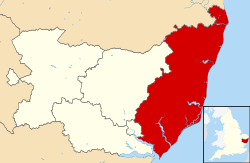East Suffolk East Suffolk District | |
|---|---|
 Beach and harbour at Lowestoft, the district's largest town. | |
 East Suffolk district within the county of Suffolk | |
| Coordinates: 52°12′N1°30′E / 52.2°N 1.5°E | |
| Sovereign state | United Kingdom |
| Constituent country | England |
| Region | East of England |
| Non-metropolitan county | Suffolk |
| Status | Non-metropolitan district |
| Admin HQ | Melton |
| Incorporated | 1 April 2019 |
| Government | |
| • Type | Non-metropolitan district council |
| • Body | East Suffolk Council |
| Area | |
• Total | 200 sq mi (510 km2) |
| Population (2021) | |
• Total | 246,058 |
| • Density | 1,210/sq mi (469/km2) |
| Ethnicity (2021) | |
| • Ethnic groups | |
| Religion (2021) | |
| • Religion | List
|
| Time zone | UTC0 (GMT) |
| • Summer (DST) | UTC+1 (BST) |
East Suffolk is a local government district in Suffolk, England. The largest town is Lowestoft, which contains Ness Point, the easternmost point of the United Kingdom. The second largest town is Felixstowe, which has the country's largest container port. On the district's south-western edge it includes parts of the Ipswich built-up area. The rest of the district is largely rural, containing many towns and villages, including several seaside resorts. Its council is based in the village of Melton. The district was formed in 2019 as a merger of the two previous districts of Suffolk Coastal and Waveney. In 2021 it had a population of 246,058. It is the most populous district in the country not to be a unitary authority.
Contents
- History
- Governance
- Political control
- Leadership
- Composition
- Elections
- Premises
- Towns and parishes
- See also
- References
- External links
The district is on the coast, facing the North Sea. Much of the coast and adjoining areas lies within the Suffolk Coast and Heaths, a designated Area of Outstanding Natural Beauty. Some northern parts of the district lie within The Broads.
The neighbouring districts are Babergh, Ipswich, Mid Suffolk, South Norfolk and Great Yarmouth.




